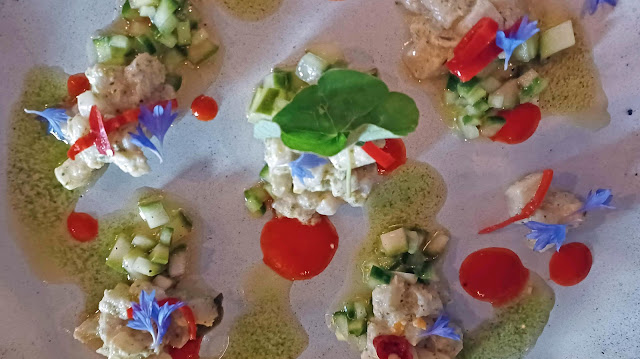Saturday night buzz at Pigalle Kitchen
 |
| Turbot starter |
Hadn’t been to Barrack Street’s Pigalle for quite a while. With our 6.00pm dinner reservation, we were among the first to get to the venue last Saturday night, and it was quiet. Only for a moment! Five minutes later, the place was full, the buzz began and never stopped. We joined with the engaging staff, as the music played, lots of chats and laughs began, and in between there were a series of expertly thought out and executed dishes from a menu that is not repeated anywhere around this town.
Many restaurants do of course use local produce and so does Pigalle: Skeaghanore Duck, Kilbrack Farm, Macroom Buffalo, Ballea Lamb (via O’Mahony’s in the English Market), Velvet Cloud, Valentia Island Vermouth, West Cork Tofu, Rossmore Oysters and much more. Lots of good organic and natural wine here also, a selection of cocktails, Beamish of course (it is the drink in this street) and also Franciscan Well. Glad to see also that Sligo’s White Hag had two taps and we went on to enjoy their Lager and Atlantean IPA.
 |
| Duck, pic via Pigalle |
We skipped the opening snacks of Rossmore Oyster with Tomatillo Chutney and the Courgette Bhaji with Macroom Buffalo Ricotta. Concentrated on the starters of which there was a short but tempting selection including a special of Razor Clams, Nduja, White Hag's Atlantean IPA Sourdough. Another featured Ballyhoura Wild Mushroom, another Macroom Buffalo Bocconcini.
No shortage of spices here and both of our choices had some. CL’s was Skeaghanore Duck Laab, House Sriracha, Kohlrabi Som Tam, Purple Basil (€10.00). Also known as Larb this a lively and lovely salad and was very much appreciated.
I picked the Turbot Ceviche, Cucumber, Yuzu, Pickled Chilli, Vietnamese Coriander (€10), a gorgeous palate-waking dish that combined South American and Asian in a cosy old spot on an ancient Cork street. Is the world getting smaller or what? No doubt though our tastes are expanding as peoples interact across the globe. Wouldn’t it be great if we could keep all interactions peaceful.
 |
| Lamb |
It wasn’t all peace and quiet here in Pigalle. Here, you talk that bit louder, laugh a little louder. There was a party in the back room but the happy vibes were all over the place and we took it all in as we sipped the beers and waited for our mains. They didn’t take long. The crew here have time for the chat but are also on the ball.
I had the wonderful rump of lamb, a captivating combination of Ballea Lamb, Marquez Sausage, Aubergine, Smoked Beetroots, and Velvet Cloud Sheep’s Yoghurt (26). A slightly offbeat ensemble really but it all came together gorgeously, the lamb had of course the lead role yet everything else on the plate, especially the beetroot and the yogurt, had their moments. Bravo! And thumbs up also for our other mains, the fish special of Pan fried Bream with Valentia Island Vermouth Velouté, Confit Fennel, and Charred Leeks (€24).
There were sides also on offer and we picked the Fried Rooftop Farm Potatoes with Hazelnut Parsley Butter (4). That rooftop farm is downtown, in Cornmarket Street, and their Green salad was another of the sides.
We weren’t, at a quick first glance, immediately impressed with the three desserts on offer but, considering what had gone before, a second reading was in order and was followed by an order. Good decision!
We went on to enjoy the Killeen Cumin Goat's Gouda, Templegall Cow's Cheese, Apple Jelly, & Crackers (€10) and also Blackberry & Cider Jelly, Marshmallow, Honey & Lavender Ice Cream (€8). The Blackberry & Cider jelly was excellent while the cheese (in generous quantities and enhanced by the superb apple jelly) was a treat. I always enjoy Hegarty’s but hadn’t come across this Killeen before (will be looking out for it now).
* Pigalle are continuing with their 3 courses for €35 option on Wednesdays and Thursdays, where all the dishes are from the main menu and that means good food and great value.












